Continuing my survey of French animation, I’ll first note that through 1950 isolated French-language animated short films, mostly theatrical animated commercials, began to appear immediately before and during World War II era. After the war, the first two men determined to create a French animation industry were Jean Image (real name: Imre Hajdú, sometimes given as Émeric André Hadjú; 1910-1989) and Paul Grimault (1905-1994).
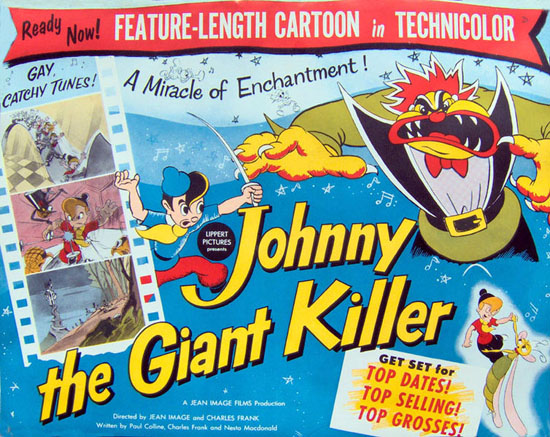
Johnny the Giant Killer (Jeannot l’Intrépede), directed by Jean Image. 58 minutes. December 13, 1950.
Made by Jean Image Films, which made several short cartoons and features in the late 1940s to 1960 for theatrical release, then added French TV animation to the theatrical animation, up until Image’s retirement shortly before his death. Jeannot l’Intrépede was lightly based on – “inspired by” might be a better term – Charles Perrault’s Le Petit Poucet, with a large dose of Maurice Maeterlinck’s La Vie des Abeilles added. Jeannot and a troop of boy scouts are camping in a forest. One night Jeannot reads a tentful of a half-dozen scouts a fairy tale book about the evil ogre (“giant” in English).
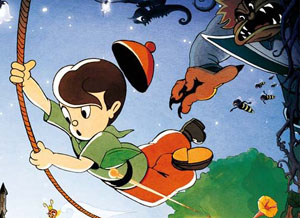 They sneak out to find the ogre’s castle, the fairy tale apparently having turned into reality. The ogre captures them all except for Jeannot, whom he shrinks to insect size. A magpie carries Jeannot from the castle to the forest, where he sees the friendly insects of Insectville, saves them from a lizard, is captured by spiders, and is rescued by bees. The bee majordomo shows him how bees live. The queen bee favors Jeannot, which makes the drones jealous. After Jeannot defeats the head drone in a sword fight, the head drone sneaks out to help the evil wasps to capture the beehive. Jeannot defeats them, and the grateful queen mobilizes all the forest insects into an army to help Jeannot defeat the ogre and rescue the other boys. Jeannot and the boys are restored to full size. The film ends with them returning to the scout camp, with the ogre shrunk to insect size in a birdcage as a souvenir.
They sneak out to find the ogre’s castle, the fairy tale apparently having turned into reality. The ogre captures them all except for Jeannot, whom he shrinks to insect size. A magpie carries Jeannot from the castle to the forest, where he sees the friendly insects of Insectville, saves them from a lizard, is captured by spiders, and is rescued by bees. The bee majordomo shows him how bees live. The queen bee favors Jeannot, which makes the drones jealous. After Jeannot defeats the head drone in a sword fight, the head drone sneaks out to help the evil wasps to capture the beehive. Jeannot defeats them, and the grateful queen mobilizes all the forest insects into an army to help Jeannot defeat the ogre and rescue the other boys. Jeannot and the boys are restored to full size. The film ends with them returning to the scout camp, with the ogre shrunk to insect size in a birdcage as a souvenir.
Johnny the Giant Killer was the first French animation since Émile Cohl’s silent short films to be theatrically released in America, on June 5, 1953 by Lippert Pictures, usually for children’s weekend matinees. Lippert’s American adapter, Charles Frank, listed himself as the co-director with Image. It was sometimes released as Johnny in The Valley of the Giants. It was advertised as “France’s first animated feature”, ignoring Starevich’s arguably non-French stop-motion feature. It won the 1951 Venice Film Festival’s Grand Prix for children’s films. But Jerry already covered it here in his post of this March 31st, and in our 26 comments, all of us who had seen it universally reviled it. For one of Jean Image’s post-Jeannot l’Intrépede theatrical shorts, the 8-minute 1956 L’Aventure du Père Noël, see my Christmasy Cartoonz, Part 5 column, last December 22nd.
La Bergère et le Ramoneur (The Shepherdess and the Chimneysweep), aka “The Adventures of Mr. Wonderbird” directed by Paul Grimault. 63 minutes. May 29, 1953.
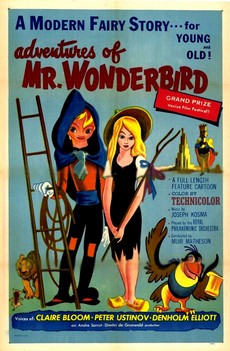 Jeannot l’Intrépede did not pretend to be more than a children’s film. Paul Grimault’s La Bergère et le Ramoneur (The Shepherdess and the Chimneysweep), on the other hand, became world-famous. The evil king’s Escheresque castle, full of decorative floor squares that open beneath the king’s victims, plunging them into the dungeons, was the acknowledged inspiration for the castle in Hayao Miyazaki’s 1979 Lupin III: The Castle of Cagliostro. Isao Takahata has also expressed his admiration for the film, which he saw in the 1950s. For me, the pseudo-ancient castle filled with modernistic and futuristic mechanical and electronic booby traps was the real star, more so than any of the human characters.
Jeannot l’Intrépede did not pretend to be more than a children’s film. Paul Grimault’s La Bergère et le Ramoneur (The Shepherdess and the Chimneysweep), on the other hand, became world-famous. The evil king’s Escheresque castle, full of decorative floor squares that open beneath the king’s victims, plunging them into the dungeons, was the acknowledged inspiration for the castle in Hayao Miyazaki’s 1979 Lupin III: The Castle of Cagliostro. Isao Takahata has also expressed his admiration for the film, which he saw in the 1950s. For me, the pseudo-ancient castle filled with modernistic and futuristic mechanical and electronic booby traps was the real star, more so than any of the human characters.
Paul Grimault’s masterpiece was premiered so many times, under so many different titles, that it is difficult to say what its real release date was. I first saw the 1952-’53 release under the American Mr. Wonderbird title. Grimault and his business partner, André Sarrut, founded Les Gémeaux (The Twins, with an allusion to Castor and Pollux) studio in 1936. After a decade of making a dozen animated shorts, they began production in 1947 of their first feature, La Bergère et le Ramoneur, based upon Hans Christian Andersen’s tale as loosely adapted by French poet and screenwriter Jacques Prévert. The perfectionist Grimault would not stop working on it. Finally Sarrut seized it and released it on May 29, 1953 in a 63-minute version; unfinished as far as Grimault was concerned. This split ended the studio. The first American release was earlier during 1952 as The Curious Adventures of Mr. Wonderbird, or just Mr. Wonderbird. After a long legal battle, Grimault got the rights to the film in 1967 and resumed production on it with Prévert as his new partner. It took Grimault ten years to get the financing. He finally finished it to his satisfaction from 1977 to 1980, releasing it on March 19, 1980 (after Prévert’s death) as Le Roi et l’Oiseau (The King and the Bird) at 87 minutes. It was newly released in America as The King and Mr. Bird. It was also shown in America in either the 1952 version or the 1980 version as The Adventures of Mr. Wonderbird, Mr. Bird to the Rescue, and The King and the Mockingbird (although Mr. Wonderbird looks more like a human-sized, and dressed multicolored, cartoon crow than a mockingbird to me.)
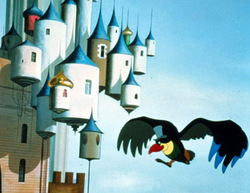 Prévert’s story is frankly confusing, but the visuals are so glorious that the viewer does not care. The Kingdom of Takicardie is ruled by the despotic King Charles V + III = VIII + VIII = XVI (Ferdinand in the American dub) in his sumptuous castle lair, reminiscent of both Louis XIV’s palace and Bavarian King Ludwig II’s Neuschwanstein Palace (the model for Disneyland’s Sleeping Beauty’s palace). It is filled with paintings and statues, most of which are more than they seem. Those of the king are idealized, mostly to show him as clear-sighted when he is really comically cross-eyed. He is a hunting fanatic and shoots at Mr. Wonderbird’s four chicks. All of his shots miss because of his crossed vision, but he has hit and killed Mr. Wonderbird’s wife by accident. That is why Mr. Wonderbird (Peter Ustinov’s voice in the American dub) is his implacable enemy.
Prévert’s story is frankly confusing, but the visuals are so glorious that the viewer does not care. The Kingdom of Takicardie is ruled by the despotic King Charles V + III = VIII + VIII = XVI (Ferdinand in the American dub) in his sumptuous castle lair, reminiscent of both Louis XIV’s palace and Bavarian King Ludwig II’s Neuschwanstein Palace (the model for Disneyland’s Sleeping Beauty’s palace). It is filled with paintings and statues, most of which are more than they seem. Those of the king are idealized, mostly to show him as clear-sighted when he is really comically cross-eyed. He is a hunting fanatic and shoots at Mr. Wonderbird’s four chicks. All of his shots miss because of his crossed vision, but he has hit and killed Mr. Wonderbird’s wife by accident. That is why Mr. Wonderbird (Peter Ustinov’s voice in the American dub) is his implacable enemy.
The king’s real headquarters is a secret room within the castle tower, dominated by paintings including the beautiful shepherdess, whom he loves, and the handsome chimneysweep, whom she loves. At night, the paintings and statues come to life. The shepherdess and the chimneysweep try to escape the palace together. They are pursued by a vain painting of the king, which is not cross-eyed. His painting deposes the real king and takes his place. (Nobody notices that the paintings are smaller than the real people.) Mr. Wonderbird helps the two lovers to escape the palace and hide in the underground village that has grown up around it. They are still pursued by the king’s loyal Chief of Police and his men. The king finally captures the shepherdess and is about to force her to marry him, but Mr. Wonderbird helps the lions, tigers, and other feral animals of the Beast Pit to escape and they break into the wedding. Other characters, good or evil, include the king’s pampered puppy, a giant automaton (or Automan) and its operator, the Palace’s majordomo, a museum guard, a blind barrel organist, and the dungeon Beastmaster.
The film is full of ingroup visual references. The underground village around the base of the palace is like the medieval French city of Carcasonne. Other famous French architectural features include the outdoor staircases of Montmartre. The bleak mood of the underground village is like Fritz Lang’s lower Metropolis combined with Charlie Chaplin’s Modern Times. The Chief of Police and his policemen look like Tintin’s two comic-relief bowler-hatted and moustached detectives. There are several extremely brief visual references to Adolf Hitler and to the Nazis. Many other references have been either specified by Grimault or theorized by the film’s critics.
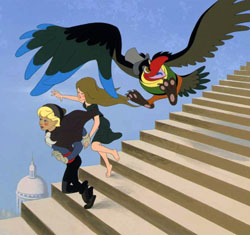 One reference that is officially unmentioned is that the sneaky, arrogant, jowly, unshaven King Charles looks suspiciously like Richard Nixon with a finicky moustache and goatee. According to the rumor, when Grimault was visiting Hollywood in 1946, just before beginning to animate Mr. Wonderbird in 1947, he saw the campaign publicity for Nixon who was then a freshman Republican running hard for the House of Representatives in California’s 12th Congressional district (that included Hollywood) in the 1946 elections. Grimault said to himself, “That man looks like a perfect villain,” and, thinking that the French public would not recognize an unknown, minor American politician, he collected all of the publicity closeups of Nixon that he could get for visual reference. By the time that Nixon became world-famous, it was too late to change.
One reference that is officially unmentioned is that the sneaky, arrogant, jowly, unshaven King Charles looks suspiciously like Richard Nixon with a finicky moustache and goatee. According to the rumor, when Grimault was visiting Hollywood in 1946, just before beginning to animate Mr. Wonderbird in 1947, he saw the campaign publicity for Nixon who was then a freshman Republican running hard for the House of Representatives in California’s 12th Congressional district (that included Hollywood) in the 1946 elections. Grimault said to himself, “That man looks like a perfect villain,” and, thinking that the French public would not recognize an unknown, minor American politician, he collected all of the publicity closeups of Nixon that he could get for visual reference. By the time that Nixon became world-famous, it was too late to change.
In 1980 Paul Grimault completed The King and the Bird to his satisfaction. What were the differences? Frankly, I preferred the 1952 feature. Besides lots more incidental scenes, Grimault gave the feature a darker and more ambiguous conclusion. Technically, the distinction between the late 1940s-early 1950s animation and the 1977-1980 animation is often jarring. The music is completely different. It is a game to watch the 1980 feature and guess which scenes are from the earlier animation and which are from the later. But if you only want to watch one movie – acknowledging that Grimault himself approved only the 1980 version — I recommend the 1952 Mr. Wonderbird.
La Bergère et le Ramoneur/Mr. Wonderbird became the last internationally-recognized French-language animated production for awhile, but during the 1950s and ‘60s French theatrical shorts were continuing and TV animation was beginning.
Below: Mr. Wonderbird in English, complete but faded & blurry.
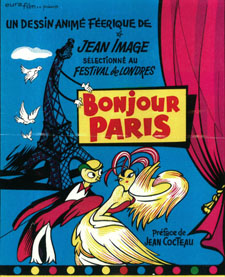 Bonjour Paris, directed by Jean Image. 68 minutes. October 30, 1953.
Bonjour Paris, directed by Jean Image. 68 minutes. October 30, 1953.
Two pigeons living on the towers of Notre-Dame Cathedral are Parisian lovers. The Cathedral’s chimeras and gargoyles try to break them up, but they fly off to see the city and visit their old friend, M. La Tour, an anthropomorphized Eiffel Tower. The day is a big holiday, when everyone in Paris goes fishing along the Seine. M. La Tour wants to join in, but he is so big and clumsy that everyone is disgusted. In a musical scene, the Eiffel Tower dreams of starring in a ballet with Big Ben, the Statue of Liberty, and the Tower of Pisa; and he runs away in despair. The people of Paris are shocked by his disappearance. The authorities decide to construct a replacement tower. Meanwhile, M. La Tour experiences the Paris subway and rediscovers the joys of life. The two pigeons warn him that he is just about to be replaced, and he hurries back to his traditional spot just as the President of France is about to proclaim the building of the new tower. He is gratified by the cheers of the Parisians for him.
Bonjour Paris portrayed Jean Image’s love affair for his adopted city. It had an introduction by Jean Cocteau. It packed in as many poetic images of the city’s landmarks as Image could; the Basilica du Sacré Coeur, the Parisian Métro, the banks of the Seine, the Moulin Rouge, the Louvre, etc. Its many songs were sung by France’s most popular singers of 1952. It was produced during 1952, but not released until October 1953, as Bonjour Paris; ou, La Tour Prend Garde (Good Morning Paris; or, Tower Beware). It became one of the first animated features shown on television, both in France and in America, under the title Bonjour Paris; On a Volé la Tour Eiffel (Good Morning Paris; Someone’s Stolen the Eiffel Tower).
Un Fée… Pas Comme les Autres (A Fairy… Not Like the Others), directed by Jean Tourane. 63 minutes. December 20, 1957.
A French-Italian co-production, shown in America as The Secret of Magic Island. Often labeled an animated feature, but really a live-action children’s film with live animals in model sets, “with some stop-motion animation” (but it looks like live offstage manipulation of brushes, artificial paws, etc. to me). The inhabitants of a little town are anthropomorphized (trained) dogs, geese, foxes, rabbits, cats, pigs, etc., semi-humanized by a good fairy. When the fairy’s magic wand is stolen by an evil Black Troll (a monkey), Per and Barbara, two ducklings in hot-air balloons, travel to the Black Troll’s island to steal it back.
Next: The Belvision Years.


 Fred Patten (1940-2018) was an internationally respected comics and animation historian. He has written about anime or comic books for publications ranging from Animation Magazine and Alter Ego to Starlog. He was a contributor to The Animated Movie Guide (2005), and is author of Watching Anime, Reading Manga (2004, Stone Bridge Press), a collection of his best essays, and Funny Animals and More (2014, Theme Park Press), based upon his early columns here on Cartoon Research. He passed away on November 12th, 2018.
Fred Patten (1940-2018) was an internationally respected comics and animation historian. He has written about anime or comic books for publications ranging from Animation Magazine and Alter Ego to Starlog. He was a contributor to The Animated Movie Guide (2005), and is author of Watching Anime, Reading Manga (2004, Stone Bridge Press), a collection of his best essays, and Funny Animals and More (2014, Theme Park Press), based upon his early columns here on Cartoon Research. He passed away on November 12th, 2018.





































He did manage to get out a couple more features in his later years such as one on Baron Munchhauen I use to see a few times on Nickelodeon’s “Special Delivery” block, and a follow up that was titled “The Secret of the Selenites” (released on home video in the US as “Mood Madness”) featuring the Baron character in a sci-fi story. Both films are also rather unique in their crappiness yet there are those that enjoyed them as a kids anyway (I’m sure I brought them up before).
And a legend was born!
Certainly was. I guess I didn’t mind the fact the peasants of the underground city all decided to move to the ‘suburbs’ and live in tents. Grimault and Prevert certainly were going for deep, social undertones with this. Certainly not a popcorn film here, you’re suppose to be thinking. 🙂
When I first watched this version courtesy of a pal of mine in Canada who sent me a tape of it 15 years back, I recall thinking of those Looney Tune movies and specials from the 1970’s and 80’s the way they tried to blend the classic animated footage with the new stuff and it just doesn’t gel right, differences in technique, materials and even talent can mean a whole lot. Grimault certainly saw this as a challenge and met it head-on. Even in the restored version it’s slightly noticable to go from the 40’s material to the 70’s and see those differences in detail and execution (The wild cats in the dungeon look very different in many shots, they apparently couldn’t handle outlining their bodies just right so it looked quite jarring to me). One thing I do miss in this version is the little kitty cat who follows the big cats questioning their motives for being ‘birds’. Obviously this new edit doesn’t need anymore ‘talking animals’ other than the main bird himself.
I noticed they do use at least one music cue from the ’52 film and that’s the song the king plays on the music box in one scene, but that’s it. The music certainly changes the mood dramatically.
Me too, now if we only had a better copy than the one that’s been put out over and over and over for the past 30 years. You’d think someone would’ve found a better print to use sooner or later (at least to see if there were more opening credits or not, given the way they mute that part on the video itself).
Years after the ‘finished’ release, Paul Grimault also made another feature film that was really a retrospective of his previous film work called “La Table Tournate”. Here’s a clip featuring the dancing doll character seen in “Le Roi et l’Oiseau”…
https://www.youtube.com/watch?v=_NRIYEV2B64
As a follow-up, here’s some images I pinned for reference, first the French poster.
http://www.pinterest.com/pin/30891947418990264/
Now the Japanese one. (not bad for an action shot)
http://www.pinterest.com/pin/30891947418990218/
And some production sketches:
http://www.pinterest.com/pin/30891947418990248/
http://www.pinterest.com/pin/30891947418990309/
http://www.pinterest.com/pin/30891947418990330/
http://www.pinterest.com/pin/30891947418990172/
I noticed around the time Andre Sarut took over the film, he was also producing cinema adverts for the UK-based Colman’s Mustard, thought I’d share these ditties too, though of course this is off-topic to say the least.
http://www.eafa.org.uk/catalogue/6566
http://www.eafa.org.uk/catalogue/125
By the way, this month, the Film Society of Lincoln Center will be playing “The King and the Mockingbird” in case anyone’s out that way.
http://www.filmlinc.com/films/on-sale/the-king-and-the-mockingbird
Can’t wait!
Thanks very much for this, Chris. I have Jean Image’s later animated features (it’s “Moon Madness”, not “Mood Madness”) and Grimault’ “La Table Tournante” to be covered in future columns, but some of your links may be very handy to illustrate them. And I did not know about Colman’s Mustard.
Thanks very much for this, Chris. I have Jean Image’s later animated features (it’s “Moon Madness”, not “Mood Madness”) and Grimault’ “La Table Tournante” to be covered in future columns,
My fault for typing too fast.
but some of your links may be very handy to illustrate them.
Thanks!
And I did not know about Colman’s Mustard.
I bothered to remember Sarrut’s name there and thought it might be interesting, perhaps he used the extra cash from these to finish Mr. Wonderbird but who knows.
Thundering thunderations! I just scored the French DVD of Jean Image’s Baron Munchausen movies. That the box text continues to refer to Image as “The French Disney” is an insult to both parties in that phrase.
And yet…well, I’m one of those people who remembers Moon Madness fondly, even though I was fully cognizant of its awful quality. Like (*looks at DVD collection*) one of the lesser Godzilla movies or (*looks again*) the more terrible Irwin Allen offerings, it was something a child could look at and say, “Well, I could do just as good as THAT!” Plus, the theme song and music by Shuki Levy is undeniably catchy.
(The French DVD, which offers both movies although Moon Madness is only briefly mentioned as an extra, is French-only. I’m going to rip and clean-up the English audio from the terrible-looking EastWestDVD discs and put ’em together. Personal note to Chris: Still working on that other project!)
For some odd reason, I remember seeing “Johnny the Giant Killer” presented in serialized form (five-minute episodes) on WOR-TV, Channel 9 in New York, back in the early 1960s. Does anyone else from the Northeast (or elsewhere) recall seeing this French animated work in that format?
I want to see the Bonjour Paris one, but I can’t find it online.